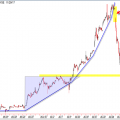The price of oil has tumbled out of its year-long trading range as investors grow increasingly nervous about the impact of a slowdown in the world’s largest economies on the demand for crude.
Brent crude, which had traded between $73 and $92 since October last year, fell as low as $68.68 on Tuesday, its lowest level since December 2021.
That came as a report showed Chinese oil imports are still below last year’s levels, adding to growing concerns about the strength of global demand.
Despite regaining some ground on Wednesday, the international benchmark is down 13 per cent since August 26, when the price was pushed higher by concerns over tight supply.
West Texas Intermediate, the US equivalent, fell as low as $65.27, the weakest since May 2023, although it rebounded 2.1 per cent on Wednesday. Brent crude hit $70.61 per barrel as Hurricane Francine disrupted oil and gas production along the US Gulf Coast.
Opec on Tuesday downgraded its forecast for 2024 oil demand growth for a second consecutive month, just days after eight members of the enlarged producer group, Opec+, said they would delay by two months a plan to unwind voluntary production cuts that were due to start in October.
“Everyone is shifting to the bearish side?.?.?.?[saying] China is bad, the US is heading lower and suddenly you are all consumed in bearish talk and very bearish sentiment,” said Bjarne Schieldrop, chief commodities analyst at SEB.
He added that, “between the lines”, he expected Opec to “accept a lower [market] price, a little bit higher volatility [and] a little bit higher uncertainty in the market”.
Other are cautious too. Citi has advised investors to sell all rallies and said the price will head towards $60 next year due to a “sizeable surplus”.
Ben Luckock, head of oil at trading firm Trafigura, told a conference before Tuesday’s drop that Brent would fall “into the $60s” relatively soon, although he also warned against being too bearish.
Some fund managers have also been anticipating weakness. “We are underweight oil stocks,” said Paul Gooden at Ninety One, adding that “we see tail risk on the downside”.

Sliding prices pose a challenge to Opec+. Despite delaying a planned increase in production of 180,000 barrels a day next month and by 540,000 b/d by the end of the year, strategists believe the group could find it hard to prop up prices.
The delay to the reversal of voluntary cuts risks permanently ceding market share to other producers, say analysts. Opec said it expected most supply growth this year to be driven by the US, Brazil and Canada.
Keeping a lid on the price of Brent, which had averaged $82.90 this year until the end of August, has been the prospect that Opec could release more oil into the market if prices rose too far.
Meanwhile, conflict in the Middle East and, briefly, a political dispute that closed large parts of Libya’s production, had been providing a floor to the market.
But the weak demand picture appears to have removed that support.
Opec’s decision to delay adding back production failed to hold up prices, indicating that “the market is not impressed and [they] were looking more for a cancellation”, said Nitesh Shah, head of commodities at ETF provider WisdomTree.
“The hard truth is that demand is too weak at the moment and therefore just postponing is not enough. They needed a bold signal that they were going to keep the production restraint on for much longer than just this two-month delay.”
The drop in prices comes at a sensitive time ahead of the US presidential election in November.
While the sell-off could favour vice-president Kamala Harris by lowering petrol prices for American drivers and helping contain inflation, the weakness in the market also signals growing concern that the US economy could be heading for a sharp slowdown.
For much of the past five years, near-term supply shortages have meant that oil priced for delivery a year ahead has traded well below near term prices, by an average of nearly $5 per barrel. But this gap has closed.
This change hints at inventories potentially rising, as might happen in a recession, said Morgan Stanley, although its economists are not themselves forecasting a recession. The bank downgraded its 2024 fourth-quarter Brent forecast from $80 to $75 a barrel, while it expected $75 to hold throughout all of 2025.
The US Energy Information Administration on Tuesday forecast crude would return to $80 per barrel this month and average $82 in the fourth quarter of the year because Opec’s production cuts will lead to a deficit, despite current concerns about slack demand.
Meanwhile, countries eager to increase production, such as the United Arab Emirates, “are now starting to accept that 2025 is not the year to increase production, instead pushing this out to 2026”, said Jorge Leon, an oil strategist at Rystad Energy and formerly at BP and Opec.
“They know that there’s no room to increase production.”



